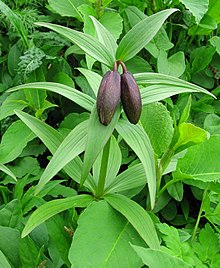Fritillaria camschatcensis
| Kamchatka lily | |
|---|---|
 |
|
| Scientific classification | |
| Kingdom: | Plantae |
| (unranked): | Angiosperms |
| (unranked): | Monocots |
| Order: | Liliales |
| Family: | Liliaceae |
| Genus: | Fritillaria |
| Species: | F. camschatcensis |
| Binomial name | |
|
Fritillaria camschatcensis (L.) Ker-Gawl. |
|
| Synonyms | |
|
|
Fritillaria camschatcensis is a species of fritillary native to northeastern Asia and northwestern North America, including northern Oregon, Washington, British Columbia, Alaska, northern Japan, and the Russian Far East (Amur, Kamchatka, Khabarovsk, Magadan, Primorye, Sakhalin and the Kuril Islands). It has many common names, typically Kamchatka fritillary or Kamchatka lily.
It is also called rice lily, northern rice-root, or (misleadingly) "Indian rice" or "wild rice", because of the rice-like bulblets that form around its roots. It is also sometimes known as skunk lily, dirty diaper and outhouse lily because of the flower's unpleasant smell.
Yet another vernacular name is "chocolate lily" because of its brown color, but that term is also applied to Fritillaria biflora (in California) or to the distantly related Arthropodium strictum whose flowers smell of chocolate.
Fritillaria camschatcensis produces bulbs with several large fleshy scales, similar to those of commercially cultivated garlic. Leaves are lanceolate, up to 10 cm long, borne in whorls along the stem. Stem is up to 60 cm tall, with flowers at the top. Flowers are spreading or nodding (hanging downwards), dark brown, sometimes mottled with yellow.
...
Wikipedia
